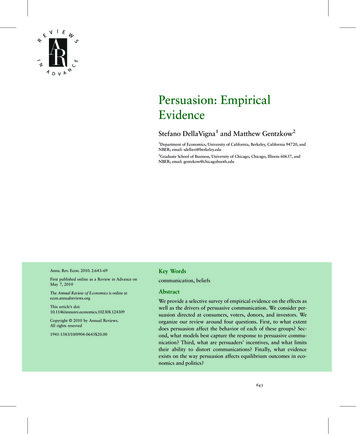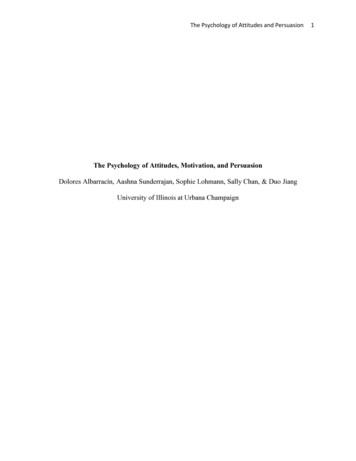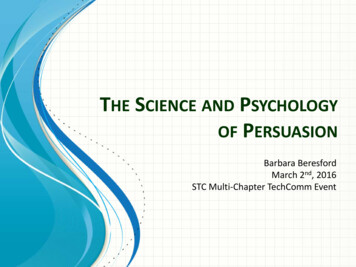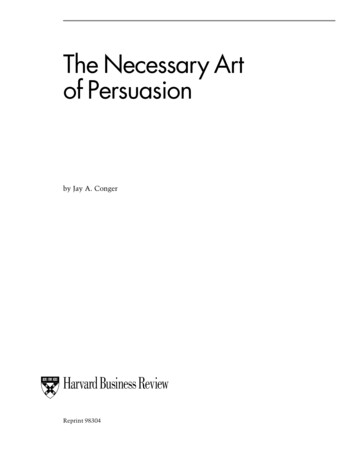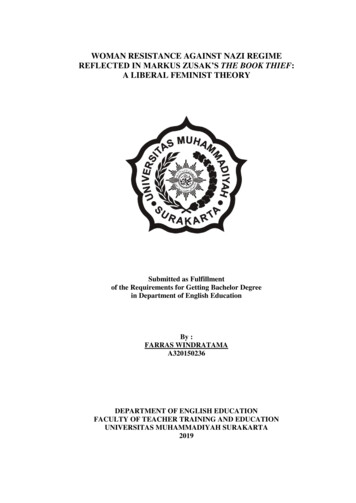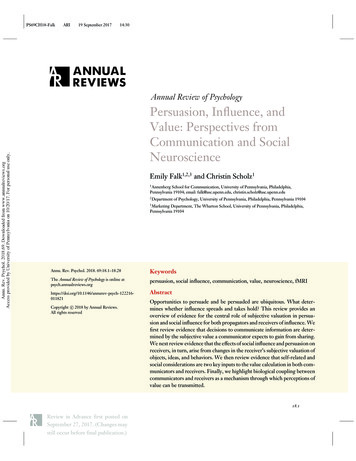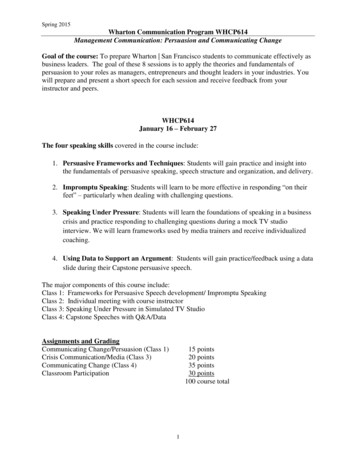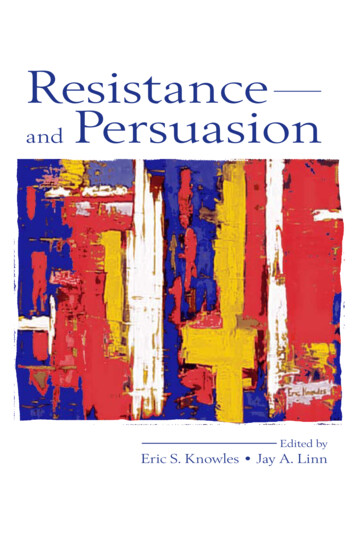
Transcription
Resistanceand PersuasionEdited byEric S. Knowles Jay A. Linn
Resistance and Persuasion
RESISTANCE AND PERSUASIONEdited byEric S. KnowlesUniversity of ArkansasJay A. LinnWidener University2004LAWRENCE ERLBAUM ASSOCIATES, PUBLISHERSMahwah, New JerseyLondon
Senior Editor:Cover Design:Textbook Production Manager:Full-Service and Composition:Text and Cover Printer:Debra RiegertKathryn Houghtaling LaceyPaul SmolenskiWestchester Book ServicesSheridan Books, Inc.Cover image is a 30" 40" oil on canvas, entitled “Resistance,” painted by Eric S.Knowles, 2003.This book was typset in 10/12 pt. Times, Italic, Bold and Bold Italic.The heads are typeset in Americana, Americana Italic, Americana Bold, and AmericanaBold Italic.Copyright 2004 by Lawrence Erlbaum Associates, Inc.All rights reserved. No part of this book may be reproducedin any form, by photostat, microform, retrieval system, or anyother means, without prior written permission of the publisher.Lawrence Erlbaum Associates, Inc., Publishers10 Industrial AvenueMahwah, New Jersey 07430www.erlbaum.comLibrary of Congress Cataloging-in-Publication DataResistance and persuasion / edited by Eric S. Knowles and Jay A. Linn.p. cm.Includes bibliographical references and index.ISBN 0-8058-4486-4 (casebound : alk. paper) — ISBN 0-8058-4487-2 (pbk. : alk.paper)1. Persuasion (Psychology)—Social aspects. 2. Opposition, Theory of. I. Knowles,Eric S., 1941– II. Linn, Jay A.HM1196.R47 2004303.3'42—dc222003060740Books published by Lawrence Erlbaum Associates are printed on acid-free paper, andtheir bindings are chosen for strength and durability.Printed in the United States of America10 9 8 7 6 5 4 3 2 1
ContentsForewordINTRODUCTION1 The Importance of Resistance to Persuasionvii13Eric S. Knowles and Jay A. LinnNATURE OF RESISTANCE IN PERSUASION2 Multiple Routes to Resisting Attitude Change1113Duane T. Wegener, Richard E. Petty, Natalie D. Smoak, andLeandre R. Fabrigar3 The Intensity of Affect and Resistance to Social Influence39Kathleen Fuegen and Jack W. Brehm4 Resisting Persuasion and Attitude Certainty: A Meta-CognitiveAnalysisZakary L. Tormala and Richard E. Petty655 Individual Differences in Resistance to Persuasion: The Role ofBeliefs and Meta-BeliefsPablo Briñol, Derek D. Rucker, Zakary L. Tormala, andRichard E. Petty836 Differentiating Individual Differences in Resistance toPersuasionRichard J. Shakarchi and Curtis P. Haugtvedt105v
viCONTENTSSTRATEGIES FOR OVERCOMING RESISTANCE1157 Approach–Avoidance Model of Persuasion: Alpha and OmegaStrategies for ChangeEric S. Knowles and Jay A. Linn1178 Looking Ahead as a Technique to Reduce Resistance toPersuasive AttemptsSteven J. Sherman, Matthew T. Crawford, and Allen R.McConnell9 Narrative Persuasion and Overcoming Resistance149175Sonya Dal Cin, Mark P. Zanna, and Geoffrey T. Fong1011Forewarnings of Influence Appeals: Inducing Resistance andAcceptanceJeffrey M. Quinn and Wendy WoodTruth or Consequences: Overcoming Resistance to Persuasionwith Positive ThinkingBlair T. Johnson, Aaron Smith-McLallen, Ley A. Killeya, andKenneth D. Levin12Decreasing Resistance by Affirming the SelfJulia Zuwerink Jacks and Maureen E. O’Brien13Creating Critical Consumers: Motivating Receptivity byTeaching ResistanceBrad J. Sagarin and Robert B. Cialdini1415193215235259Consumer Psychology and Attitude ChangeCurtis P. Haugtvedt, Richard J. Shakarchi, Bendik M.Samuelsen, and Kaiya Liu283CONCLUSION299The Promise and Future of Resistance and PersuasionEric S. Knowles and Jay A. Linn301About the Contributors311Author Index317Subject Index331
ForewordDo we need to convince you that persuasion is an important topic for the socialsciences? Probably not. You know that humans are social beings. Our communication, psychology, social organization, political structures, marketchoices—in short, everything we do—is interpersonally coordinated. Persuasionis one of the important tools to achieve these alliances.What about resistance? Do we need to convince you that resistance is themost important element in the persuasion process? Well, we believe it is. Resistance is an initial condition for persuasion. Without resistance, persuasion,like preaching to the choir, is unnecessary babble. It is the resistance that requires persuasion.It is our view that resistance is the key element in persuasion. But it also isa neglected element. Most of the research from communication, marketing, social psychology, and political psychology has considered persuasion a way toincrease the power of the message. Resistance reduction is a different side tothe persuasion equation, one that has been relatively unexplored so far. We hopethat this volume will focus attention on this other half—the neglected half—ofthe persuasion process.CONCEPTIONWe remember the moment this book was conceived. It was the first day ofFebruary, 2001, in San Antonio, Texas. The meeting of the Society for Personality and Social Psychology was just about to begin, and Eric heard Bob Wicklund and Jack Brehm talk about dissonance theory at the first attitudesvii
viiiFOREWORDpreconference. Brehm had originated the idea of “reactance” 35 years before,and Wicklund had published an early book on this topic. Over the next twodays, Eric talked to each of them about accomplishing persuasion by reducingresistance and asked them if they would (a) come to Fayetteville, Arkansas, totalk about this issue, and (b) contribute to a book that presents the ideas discussed. Both men were excited and full of ideas, and both said yes. Armed withthese two lead authors, we set about writing a conference prospectus, invitingspeakers, arranging funding, and eventually finding a publisher for a book thatwould explore influence mechanisms that work by removing resistance. Eventually, Bob Wicklund was unable to participate in this project, though he hasmuch to say. Eric remembers fondly the spring weekend in 1991 that he spentat Bob’s house in Bielefeld, Germany, discussing nearly everything worth discussing.We held our conference on resistance and persuasion in Fayetteville on April12–13, 2002. Twenty-four of the 31 chapter authors were in attendance, presented papers, and participated in lively discussions about the general topic andthe specific chapters. This participation in the conference and in the discussionswas very useful as authors turned their papers into chapters. We asked authorsto attend to the general issues, such as the definitions of resistance, and to theissues raised in other chapters. We also exerted strong editorial control to ensurethat these requests were followed. The result is a book that is much more coherent and integrated than most edited volumes.ORGANIZATION OF THE BOOKYou will find four sections in this book. The first section, “Introduction,” contains the introductory chapter (Chapter 1), which describes “The Importance ofResistance to Persuasion.” It also describes the other chapters in the book ingreat detail. This introduction is followed by two multichapter sections. Thesecond section presents five chapters that discuss “The Nature of Resistance inPersuasion” and focus on the definition and operation of resistance as an attitude(Chapter 2, Chapter 4), as an affective feeling (Chapter 3), and as an individualdifference (Chapter 5, Chapter 6). The third section presents eight chapters thatdiscuss various “Strategies for Overcoming Resistance.” The first chapter in thissection (Chapter 7) introduces a distinction between Alpha strategies and Omegastrategies for persuasion. Alpha strategies attempt to overwhelm resistance bybuilding up the desirable reasons that promote attitude change and compliance.Omega strategies, on the other hand, attempt to remove or deal with the resistance to persuasion or change. Omega strategies promote attitude change andcompliance by reducing a person’s reluctance. The seven other chapters in thissection discuss other avenues for dealing with a person’s resistance: Pushing adecision into the future (Chapter 8), using narratives to sidestep resistance(Chapter 9), forewarning a person of a persuasive attempt (Chapter 10), em-
ixFOREWORDphasizing positive thoughts about the message (Chapter 11), affirming the self(Chapter 12), training people to identify illegitimate messages (Chapter 13), andusing resistance against itself, as studied in consumer psychology (Chapter 14).A final section in the book contains one chapter (Chapter 15) that puts theprevious chapters into an integrated perspective and leads readers away fromthese chapters toward future, unstudied issues in resistance and persuasion.TARGET AUDIENCEThis book is aimed broadly at those social sciences that study persuasion, including communication, marketing, political science, social psychology, journalism, advertising, and consumer psychology, and also at those arts andsciences that use persuasion. The target readers are professionals, professors,graduate learners of persuasion, and persuasion practitioners who are interestedin the theoretical underpinnings of their practice. We see this as a must-havebook in the professional library of these target readers. We have also designedit to be used in graduate courses and advanced undergraduate courses on socialinfluence and persuasion. The integration, organization, and flow of the chaptersare especially suited to a course format.It is our hope that readers will be excited and invigorated by the ideas presented here, that researchers will be filled with new hypotheses and researchquestions, that practitioners will appreciate the value of addressing resistance asa persuasion tool, and that textbook writers will have more than enough materialto create a new chapter or expanded section on resistance and persuasion.ACKNOWLEDGMENTSMany people contributed to this volume. First, we are indebted to the 31 authorswho put considerable effort into the writing and revisions of their chapters.Second, we are extraordinarily grateful for the production and marketing programs at Lawrence Erlbaum Associates and Westchester Book Services thatmade these pages and put them in your hands. Third, we are grateful to ourfunding sources for the conference, the National Science Foundation and theMarie Wilson Howells Fund, who encouraged this project from the first momentthey heard about it. Fourth, we need to thank the Omega Lab, our researchgroup at the University of Arkansas, who sustained us through this book andwho, for four days, were chauffeur, host, companion, gofer, and fan for theauthors who attended the conference. Fifth, we appreciate the public relationsand press that were provided so ably by Allison Hogge and our Omega Labpublicist, Elizabeth Hartman. Finally, specific individuals who need to bethanked for various tasks and encouragements are Steve Breckler, Dave Schroeder, Joel Freund, Angelo Welihindha, Christine Rufener, Heather Renfroe,
xFOREWORDRenee Boeck, Amira Al-Jiboori, Karissa McKinley, Karen Naufel, Mary LouWommack, Cheryl Gober, Elizabeth Knowles, Debra Riegert, Susan Barker, andKaryn Slutsky.—Eric S. Knowles, Fayetteville, Arkansas—Jay A. Linn, Chester, Pennsylvania
Resistance and Persuasion
Introduction
1The Importance ofResistance to PersuasionEric S. KnowlesUniversity of ArkansasJay A. LinnWidener UniversityThis book explores persuasion by considering its antithesis: resistance. Resistance hounds persuasion the way friction frustrates motion. To accomplish thelatter, you have to expect and, preferably, manage the former. It makes sensethat those who desire to understand persuasion should also seek to understandthe nature and operation of resistance to persuasion.As the next 14 chapters show, the focus on resistance does more than supplement the study of persuasion. It opens new windows to the processes involvedin persuasion and unlocks a storehouse of new influence strategies. The following chapters show how resistance can be reduced, and therefore persuasionachieved, by training people to be appropriately resistant, by postponing consequences to the future, by focusing resistance on realistic concerns, by forewarning that a message will be coming, by simply acknowledging resistance,by raising self-esteem and a sense of efficacy, and by consuming resistance.New insights, new influence strategies, and new facets of persuasion emergefrom a focus on resistance.3
4KNOWLES AND LINNDEFINITIONS OF RESISTANCEPsychological resistance is a broad term, with a long and varied history, thatrefers to a variety of specific events. The term has been used to refer to thenoncompliance with a directive (Newman, 2002), a desire to counteract someoneelse’s attempt to limit one’s choices (Brehm, 1966), unwillingness to achieveinsight about the real nature of one’s thoughts or feelings (Messer, 2002), avoidance of unpleasant or dangerous feelings (Perls, Hefferline, & Goodman, 1951),or the feeling of ambivalence about change (Arkowitz, 2002).Perhaps it is fair to say that resistance is a concept with a clear nucleus andfuzzy edges. As editors, we asked authors to be attentive to the issue of definition, to articulate the definitions and definitional issues raised by their topicand approach. This first chapter will start the defining process generally and thenproceed to discussing the varieties and dimensions of psychological resistance.Webster’s New World College Dictionary includes these four definitions ofresistance: (a) “The act of resisting, opposing, withstanding, etc.,” (b) “Poweror capacity to resist,” (c) “Opposition of some force . . . to another or others,”and (d) “A force that retards, hinders, or opposes motion. . . .” The first of thesefour definitions references resistance as a behavioral outcome, the act of withstanding influence. The other three reference more motivational aspects of resistance, as a power or oppositional force.Clear CoreResistance to persuasion is familiar to anyone who has offered advice or counseling, delivered a sales pitch, or tried to enlist others in a plan of action. Resistance can be seen in a smirk, that stare of inattention, the sentence that begins,“Well, perhaps, but . . .” The clear core of the definition of resistance is that itis a reaction against change. It becomes evident in the presence of some pressurefor change. McGuire (1964) set the stage for discussions of resistance to persuasion. He was interested primarily in increasing people’s ability to resist unwanted influence, a concern shared by Sagarin and Cialdini (this volume).McGuire defined resistance to persuasion as the ability to withstand a persuasiveattack. McGuire treated resistance as a variable potential (rather than kinetic)response, ready to spring forward when needed. It could be built up throughinoculation or bolstering, perhaps diminished in other ways, but it was a propertyof the person, the potential to resist persuasion. McGuire’s inoculation strategiesincreased resistance in two ways, first, by increasing motivation to resist, andsecond, by arming the person with the weapons needed to accomplish the resistance. The Sagarin and Cialdini (this volume) chapter details the importanceof both of these features of resistance. Interestingly, we will see from the Sagarinand Cialdini chapter that the story does not end there. Training people to resistpersuasion has other consequences that McGuire (1964) didn’t anticipate. Sagarin and Cialdini’s research shows that training people to resist illegitimate
1.THE IMPORTANCE OF RESISTANCE TO PERSUASION5sources has the attendant effect of allowing them to be more easily persuadedby legitimate sources. Focusing resistance and providing success experiences atresisting illegitimate sources frees the trained participant to be more receptiveto other, perhaps more appropriate and useful persuasion.Outcome Versus MotiveResistance has acquired a dual definition in psychology. On the one hand, itdefines an outcome: the outcome of not being moved by pressures to change.On the other hand, it identifies a motivational state: the motivation to opposeand counter pressures to change.In part, the distinction is driven by methodology, whether the research hasaccess to the experience or just to the result. Several chapters in this volumeemploy meta-analyses, where various studies of attitude change are characterizedand compared (Quinn & Wood, this volume; Johnson, Smith-McLallen, Killeya,& Levin, this volume). This methodology has to rely solely on the outcome ofpersuasion, whether and how much the persuasive attempt was effective. Thereliance on the behavioral outcome raises an interesting definitional issue. Insome cases a persuasive message, even a very strong one, has no effect on therecipient. A strong change attempt leaves the recipient unchanged. In other casesa persuasive message may produce a boomerang effect. The recipient changesin a direction opposite to the one advocated in the message. Are these two thesame? Are they both resistance? Johnson et al. (this volume) tussle with thisproblem and decide to investigate boomerang effects separately from the absenceof change.Defining resistance as a motivational desire raises other issues. Motivationsto oppose may not result in behavioral resistance. As Wegener, Petty, Smoak,and Fabrigar (this volume) and Tormala and Petty (this volume) discuss, resistance may not alter the outcome, but it may affect other reactions to the influenceattempt.To some extent the outcome and motivational definitions are theoreticallylinked. A motivation to oppose would promote the outcome of not changing.However, the two definitions are also not completely overlapping.Resistance as AttitudeOne model of attitude structure distinguishes three components: affective, cognitive, and behavioral. This tripartite model applies to resistance as well. “I don’tlike it!”, “I don’t believe it!”, and “I won’t do it!” are the affective, cognitive,and behavioral components of resistance, respectively. Some authors focus moreon one component, some authors on another. Studies of the failure to complywith a request (e.g., Quinn & Wood, this volume; Johnson et al., this volume)reference resistance through the behavioral component. Studies of counterarguing to a persuasive message or evaluating outcomes in the future (e.g., Haugtvedt, Shakarchi, Samuelson, & Liu, this volume; Sherman, Crawford, &
6KNOWLES AND LINNMcConnell, this volume; Wegener et. al, this volume) reference resistance primarily through the cognitive component. Studies of changes in preferences foralternatives or action (e.g., Knowles & Linn, this volume; Jacks & O’Brien, thisvolume) seem to place more emphasis on the affective components of resistance.Source of ResistanceAlthough resistance is a response to pressures for change, the source of resistance is sometimes attributed more to the person, and sometimes it is attributedmore to the situation. Many of the chapters in this volume identify or positstable individual differences in resistance, and in doing so, presume that resistance to be largely a quality of the person (cf., Briñol, Rucker, Tormala, &Petty, this volume; Shakarchi & Haugtvedt, this volume), or the person’s attitude(Wegener et al., this volume). As a stable quality of the person, resistance liesin wait, a potential response always ready to be enacted if needed.Brehm’s (1966; Brehm & Brehm, 1981) wonderful concept of “reactance”emphasizes a different source for resistance, an external source. Reactance, asused by Brehm (1966), is caused by external threats to one’s freedom of choice.When a person senses that someone else is limiting his or her freedom to chooseor act, an uncomfortable state of reactance results, creating motivation to reassertthat freedom. This externally provoked contrariness initiates oppositional feelings and behaviors; the reactant person likes the forbidden fruit even more, andfinds ways to enact the banned behavior. Two sets of factors determine theamount of reactance (Brehm, 1966; Brehm & Brehm, 1981). One set concernsthe freedoms that are threatened. The more numerous and important the freedoms, the greater the reactance to losing them. A second set of factors concernsthe nature of the threat. Arbitrary, blatant, direct, and demanding requests willcreate more reactance than legitimate, subtle, indirect, and delicate requests.Without the threat, there would be no resistant reaction, so reactance is, as thename implies, reactant, and thus stands in contrast to the forms of resistancethat are more intrinsic, permanent parts of the person or attitude. The chapterby Fuegen and Brehm (this volume) illustrates new information about the reactant process. It apparently is more fragile than first thought—weak threatsseem not to raise this reaction, and very strong threats apparently overcome it.FOUR FACES OF RESISTANCE:REACTANCE, DISTRUST, SCRUTINY,AND INERTIAAs we think about the nature of resistance, we identify four different but probably related faces. We think of these not as different kinds of resistance, but asdifferent perceptual stances toward it, much the same way an object viewedfrom four directions may present varied retinal projections but still be seen asthe same entity.
1.THE IMPORTANCE OF RESISTANCE TO PERSUASION7ReactanceOne face of resistance is the reactance described by Brehm (1966). This face ofresistance recognizes the influence attempt as an integral element of resistance.Reactance is initiated only when the influence is directly perceived and when itthreatens a person’s choice alternatives. This view of resistance also emphasizesthe affective (“I don’t like it!”) and motivational (“I won’t do it!”) sides ofresistance.DistrustAnother face of resistance spotlights the target of change, and it reveals a generaldistrust of proposals. People become guarded and wary when faced with a proposal, offer, or message to change. They wonder what the motive behind theproposal might be, what the true facts are. This face of resistance underlies bothaffective (“I don’t like it!”) and cognitive (“I don’t believe it!”) reactions toinfluence. We chose to describe this face as “distrust” rather than “paranoia”because some degree of this wariness seems legitimate. The persuader’s goalsmay be divergent from the target’s goals and may, in fact, be exploitive.ScrutinyA third face of resistance is a general scrutiny that influence, offers, or requestscreate. When people become aware that they are the target of an influenceattempt, a natural reaction is to attend more carefully and thoughtfully to everyaspect of the situation (Langer, 1989; Petty & Cacioppo, 1986). This is a formof resistance that puts emphasis on the proposal itself. The careful scrutiny ofthe proposal means that each point is examined more carefully and questionedmore thoroughly. The strengths of an argument are appreciated and accepted,and to that extent the proposal is believed. But, the weaknesses of an argumentare exposed, evaluated, and countered, and to that extent, the proposal is rejected. Several chapters in this volume emphasize this scrutiny face of resistanceand illustrate the many ways that this primarily cognitive element (“I don’tbelieve it!”) works. Wegener et al.’s chapter on multiple routes to resistance topersuasion discusses the many, often subtle ways this form of resistance works.The scrutiny face is also discussed in the chapter by Johnson et al. (this volume)on the power of positive thinking and in the chapter by Haugtvedt et al. (thisvolume), which explores resistance in consumer psychology.InertiaA fourth face of resistance might be called inertia. This is a face that is notreactant to the proposer or the proposal, and it doesn’t necessarily lead to greaterscrutiny, distrust, or reactance. Inertia is a quality that focuses more on stayingput than on resisting change. It is one face of the great equilibrium motive
8KNOWLES AND LINN(Heider, 1946) that attempts to keep the attitude system in balance. To the extentthat a request, an offer, or a persuasive message asks for change in affect,behavior, or belief, the inertia of personality and attitude frustrates that change.However, this form of resistance has more in common with the drag of an anchorthan with the antagonism of the provoked.CONCLUSIONResistance is the tug-of-war partner with persuasion. Just as it takes two opposing teams for a tug-of-war competition, resistance and persuasion are opposing yet integral parts of a persuasive interaction. However, treatments ofpersuasion in psychology, communication, rhetoric, political science, and marketing most often overlook, or at least underplay, the role of resistance in theprocess. Typically, when resistance is discussed, McGuire’s (1964) research oninstilling greater resistance through inoculation and bolstering is treated in aseparate and isolated section. This segregation fails to appreciate the full implications of McGuire’s contribution and the crucial role that resistance plays inall persuasion. McGuire (1964) identified the interplay between persuasive challenges and resistance to influence as a dynamic process, McGuire’s system identified motivation and argument as the elements involved in change. If the personhad few counterarguments and little motivation, then he or she was easily persuaded; but if motivation were increased and counterarguments made available,then influence could be resisted. This is a view that is echoed in the Knowlesand Linn (this volume) chapter that explores the implications of this approach–avoidance model of persuasion. The key element is that complex situations likepersuasive messages, offers, or commands set up conflicting motives. The ambivalence of the situation (Arkowitz, 2002) is one of its hallmarks. And, likeany nonlinear system, the interplay of these opposing forces can yield interesting, unexpected, and sometimes paradoxical consequences.A LOOK AHEADThis book seeks to do two things. First, it strives to establish resistance as alegitimate, informative, and coequal member, along with the influence attempt,of the persuasive duo. The chapters as a set define, dissect, understand, andexplain the roles of resistance in persuasion. As many of the chapters show, theprocesses of resistance are not simply the inverse of persuasion. Resistance hasits own dynamic, often quite complex, often quite malleable. Second, this bookdemonstrates the benefits of adding resistance to the persuasive equation. Asyou will see in the chapters, there are many new revelations about persuasionmade available by a focus on resistance. The chapters demonstrate a number ofnew ways that influence might be promoted or inhibited by focusing on resistance rather than on the persuasive message. We will see that simply acknowl-
1.THE IMPORTANCE OF RESISTANCE TO PERSUASION9edging resistance goes part way to reducing it (Knowles & Linn, this volume;Wegener et al., this volume), that raising reactance to a message makes a strongmessage more persuasive (Haugtvedt et al., this volume), that training people toidentify illegitimate sources of information makes them more persuaded by legitimate sources (Sagarin & Cialdini, this volume), that putting arguments intoa narrative rather than a message increases their influence (Dal Cin, Zanna, &Fong, this volume), and that affirming the target seems to reduce resistance topersuasion in general (Jacks & O’Brien, this volume). These resistance-basedinfluence approaches, other insights about resistance, and other strategies to create or combat change await you in the chapters ahead.REFERENCESArkowitz, H. (2002). Toward an integrative perspective on resistance to change. Journal of ClinicalPsychology, 58, 219–227.Brehm, J. W. (1966). A theory of psychological reactance. New York: Academic Press.Brehm, S. S., & Brehm, J. W. (1981). Psychological reactance: A theory of freedom and control.New York: Academic Press.Heider, F. (1946). Attitudes and cognitive organization. Journal of Psychology, 21, 107–112.Langer, E. J. (1989). Mindfulness. Reading, MA: Addison-Wesley.McGuire, W. J. (1964). Inducing resistance to persuasion: Some contemporary approaches. In L.Berkowitz (Ed.), Advances in experimental social psychology (Vol. 1, pp. 191–229). New York:Academic Press.Messer, S. B. (2002). A psychodynamic perspective on resistance in psychotherapy: Viva la resistance. Journal of Clinical Psychology, 58, 157–163.Newman, C. A. (2002). A cognitive perspective on resistance in psychotherapy. Journal of ClinicalPsychology, 58, 165–174.Perls, F., Hefferline, R., & Goodman, P. (1951). Gestalt therapy: Excitement and growth in thehuman personality. New York: Julian.Petty, R. E., & Cacioppo, J. T. (1986). Communication and persuasion: Central and peripheralroutes to attitude change. New York: Springer-Verlag.Webster’s new world college dictionary (4th ed.). (1999). New York: Wiley.
Nature of Resistancein Persuasion
2Multiple Routes toResisting Attitude ChangeDuane T. WegenerRichard E. PettyPurdue UniversityThe Ohio State UniversityNatalie D. SmoakLeandre R. FabrigarPurdue UniversityQueen’s UniversityAs many of the chapters in this volume illustrate, attempts at persuasion mightoften benefit from techniques aimed at addressing the “resistance” forces working against acceptance of a persuasive appeal. For example, young smokers oftenresist messages aimed at getting them to stop smoking, preferring to believe thatthe highly publicized health risks are exaggerated or do not apply to them (e.g.,Milam, Sussman, Ritt-Olson, & Clyde, 2000; see also Coleman, Stevenson, &Wilson, 2000). If one were able to convince young smokers that the risks doapply to them or that the risks are greater than they currently believe, this wouldcertainly increase the effectiveness of an appeal that rests on these reasons notto smoke. “Addressing resistance” can also be substantially less direct. For example, Linn and Knowles (2002) increased the effectiveness of a persuasiveappeal by simply acknowledging that the message recipient would pro
cial psychology, and political psychology has considered persuasion a way to increase the power of the message. Resistance reduction is a different side to the persuasion equation, one that has been relatively unexplored so far. We hope that this volume will
